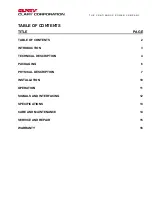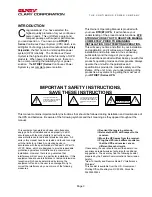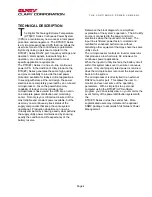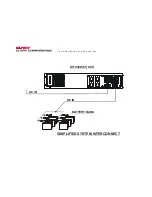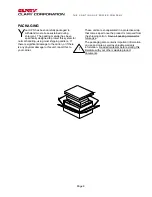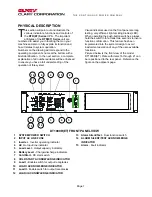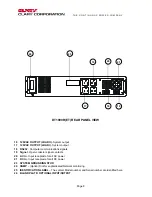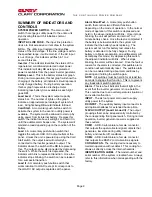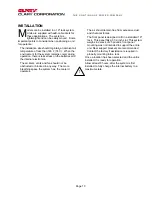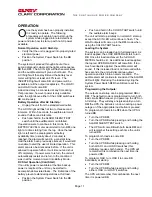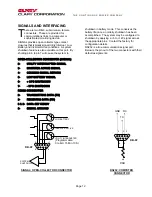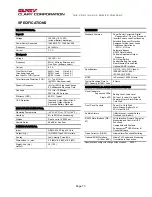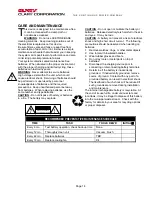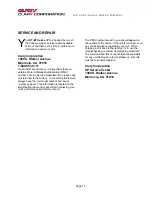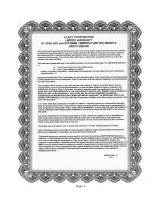
T H E C O N T I N U O U S P O W E R C O M P A N Y
Page 11
OPERATION
nce the system has been properly installed,
it is ready to operate. The following
procedures will explain how to start-up the
system while plugged into rated electrical
power and also how to start-up with no AC power
available.
Normal Operation on AC Start-Up:
•
Verify that the unit is plugged into properly rated
electrical power.
•
Position the System Power Switch to the
ON
position.
The system will proceed through about a three
second diagnostic where all the lights will sequence
ON
then
OFF
. The AC IN light will flash several times
and the audible alarm will give a short burst. The
AC IN light will then stay
ON
and the battery level
meter will light to at least an 80% level. The
INVERTER light will come
ON
. and power will be
available at all the output receptacles. The LOAD I
and LOAD II will come
ON
.
Actual load may be connected at any time during
this procedure, however power is only available
when the light above either of the LOAD switches is
ON
continuously.
Battery Operation after AC Start-Up:
•
Unplug the unit from the standard wall outlet.
The AC ON light will flash at two to three second
intervals. Within 5 seconds, the audible alarm will
sound at half-second intervals.
•
Push and hold in the ALARM SILENT/TEST
switch until the audible alarm is inhibited.
If operation were to continue in this mode, the
BATTERY LEVEL meter would start to turn
OFF
, one
light at a time starting from the top. Once the last
light is left and the preprogrammed battery
availability time (usually about 2 minutes) is
reached, the alarm will sound in a constant tone.
Had the alarm been previously silenced, it would still
re-enable to alert the user of limited operation. This
alarm can also be silenced as before. If the unit is
allowed to operate further, it will time out and shut
off completely. If power were to return, the unit will
automatically restart and return to the condition it
was in at the moment it went into
Battery
Mode
.
DC Start Operation (Cold Start)
If no utility power is available at the time backup
power is required, the unit may be started to
accomplish abbreviated tasks. The limitations of the
battery prevent extended operations at full load.
•
Position the System Power Switch to the
ON
position.
•
Push and hold in the COLD START switch until
the audible alarm beeps.
The unit will start up similarly to normal AC start-up
except the AC IN LED will continue to flash. The
LOAD outputs will come up in the
OFF
mode when
using the COLD START feature.
Loading the System
The system can be loaded up to full rated load. As
load is applied, the LOAD METER will start to turn
ON
. Once full load is achieved, the full LOAD
METER should be lit. As additional load is applied,
the top red OVERLOAD LED will come
ON
. If too
much overload is applied, the audible alarm will
sound. If this increased load is not removed within
five seconds, the unit will discontinue output
operation and latch into an alarm condition. The
audible alarm will continue to sound and the ALARM
LED will light. Reducing the load and cycling the
System Power Switch
OFF
then
ON
can reset the
system.
Programming the Outputs:
The outputs on startup can be programmed
ON
or
OFF
. The default mode is programmed to turn both
load circuits
ON
whenever you power up the UPS on
AC startup. They will stay energized until you turn
OFF
the UPS, the batteries run down during a power
outage or if the appropriate load button is pressed.
To program both loads to be
OFF
when the UPS is
turned
ON
:
•
Turn the UPS
OFF.
•
Turn the UPS
ON
while pressing and holding the
ALARM SILENT/TEST switch.
•
The UPS will come
ON
with both loads
OFF
and
will remember this setting each time the unit is
turned
ON
.
To program both loads to come
ON
:
•
Turn the UPS
OFF.
•
Turn the UPS
ON
while pressing and holding
both LOAD I and LOAD II switches (this
definitely requires both hands). The UPS will
remember this combination the next time it is
powered
ON
.
To program LOAD I or LOAD II to come
ON
individually at startup:
•
Turn the UPS
OFF.
•
Turn the UPS
ON
while pressing and holding
either LOAD I or LOAD II switches.
The UPS will remember this combination the next
time it is powered
ON
.
O
Содержание DT1000R
Страница 16: ...Page 16...


